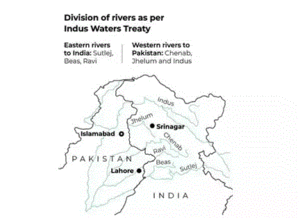General Munir’s Pakistan.
Relevance:
GS Paper-2
- India and its Neighbourhood- Relations
- Bilateral, Regional, and Global Groupings and agreements involving India and/or affecting India’s Interest.
Introduction:
The recent publication of General K.M. Munir’s book, “Pakistan: The Untold Story”, has reignited the debate about the origins and nature of Pakistan.
Current Situation in Pakistan:
Political Turmoil:
- Ongoing political crisis since April 2022, triggered by the removal of former PM Imran Khan through a vote of no confidence.
- The army has been sent in to stabilise the domestic situation, but a long-term solution to address complaints is questionable
- Protesters attacked military facilities, which made the situation like civil instability
Economic Struggles:
- Inflation soaring above 30%, eroding purchasing power and affecting essential commodities.
- Pakistani rupee experiences a steep 30% depreciation against the US dollar within a year and Foreign exchange reserves decline to a 9-year low.
- Accumulated public debt reaches a staggering USD 250 billion, compounded by the failure to secure an IMF bailout due to reform shortcomings.
Taliban’s Ascendancy:
- Post US troop withdrawal from Afghanistan, Pakistani Taliban (TTP) expands presence in Balochistan and Punjab.
- TTP’s bold attacks challenge Pakistan’s armed forces, resulting in a dual-front confrontation.
- Pakistan’s military, once viewed as formidable, faces difficulties countering TTP, eroding its aura of invincibility.
Threats to India:
Escalation of Cross-Border Tensions:
- Pakistan’s internal turmoil may lead to heightened cross-border tensions, particularly along the Line of Control (LoC) in Kashmir.
- Possibility of Pakistan diverting attention through support for militant groups or violation of ceasefire agreements to rally public backing.
Potential Refugee Crisis:
- Pakistan’s economic predicament could precipitate a refugee crisis, with millions seeking refuge outside its borders.
- This influx could strain India’s resources, possibly leading to increased crime and social unrest.
Compromised Regional Security:
- Pakistan’s domestic crisis may render it reliant on neighboring countries for support. Such dependence could escalate tensions between Pakistan and its neighbors, including India.
Nuclear Proliferation Concerns:
- Political or economic instability in Pakistan could weaken its control over its nuclear arsenal. This might raise concerns regarding the security and safety of these weapons, potentially destabilizing the region.
Opportunities for India-
Enhanced Diplomatic Influence:
- India can capitalize on Pakistan’s internal upheaval to bolster its diplomatic stance on regional security matters.
- The crisis provides an avenue to spotlight concerns about transnational terrorism, encouraging international pressure on Pakistan to address these issues effectively.
Strengthened Counterterrorism Collaboration:
- Shared security challenges prompt increased willingness from global partners to collaborate with India.
- Strengthened intelligence sharing and cooperation can curtail cross-border infiltration and thwart terrorist activities.
Regional Leadership Projection:
- Amidst Pakistan’s internal turmoil, India can exhibit its ability to maintain stability and address regional issues adeptly.
- Fostering robust regional alliances and partnerships, especially within South Asia and the Middle East, can elevate India’s profile as a responsible regional power.
Historical Background on India-Pakistan Relations
| Year | Event |
| 1947 | British partitioned Indian subcontinent into secular India and Muslim Pakistan on August 15 and 14, respectively. Partition led to massive migrations, rioting, and bloodshed. |
| 1947-48 | First war between India and Pakistan over Jammu and Kashmir. War ended with UN-declared cease-fire and Karachi Agreement. |
| 1952/1954 | Delhi Agreement granted special status to Jammu and Kashmir within Indian Constitution. State ratified accession to India in 1954. |
| 1965 | Second war over Jammu and Kashmir. War ended with Tashkent Declaration, facilitated by Soviet Union and United States. |
| 1971 | Third war over East Pakistan (now Bangladesh). Bangladesh emerged as a new nation. |
| 1972 | Simla Agreement signed, guiding future India-Pakistan ties. Ceasefire line designated as new “Line-of-Control (LoC).” |
| 1992 | Joint Declaration Prohibiting Use of Chemical Weapons signed. Both nations ratified Chemical Weapons Convention (CWC). |
| 1999 | Vajpayee visited Pakistan, Lahore Declaration signed. Kargil war followed. |
| 2001 | Armed attack on Indian parliament. LeT and JeM responsible. |
| 2008 | Terrorist attacks in Mumbai. Attackers claimed LeT affiliation. |
| 2009 | Mumbai attacks plotted in Pakistan, denied official involvement. |
| 2013 | India-Pakistan PMs met, halted hostilities in Jammu and Kashmir. |
| 2016 | Pathankot airbase attack by JeM. Uri attack, surgical strikes by India. |
| 2019 | CRPF attack by Jaish-e-Mohammed, retaliatory airstrikes. Revocation of Article 370 in Jammu and Kashmir. |
Relations between India and Pakistan-
Kashmir Issue:
- Pakistan’s Kashmir policy has been reactive, responding to India’s moves in the region.
- Indian government’s efforts to integrate Jammu and Kashmir, including revoking Articles 370 and 35A.
- Granting of Union Territory status to Jammu and Kashmir opposed by Pakistan, leading to tensions.
Indus Waters Treaty:
- Established on September 19, 1960, with World Bank mediation.
- India controls the Ravi, Beas, and Sutlej rivers; Pakistan manages the Indus, Jhelum, and Chenab.
India-Pakistan Trade Relations:
- Bilateral trade volume remains limited despite their economic sizes.
- In 2018-19, India’s exports to Pakistan totalled $2.06 billion, while imports stood at $495 million.
- Trade suspension following the Pulwama terror attack in 2019.
Kartarpur Corridor:
- Connects the Sikh shrines of Dera Baba Nanak in India and Gurdwara Darbar Sahib in Kartarpur, Pakistan.
- Inaugurated on November 9, 2019, offering Indian pilgrims visa-free access to Gurdwara Darbar Sahib.
Conclusion:
Dealing with Pakistan’s complex dynamics requires strategic foresight. While engaging with Pakistan’s establishment is complex, allowing the ascent of extremism presents even graver consequences. India must work towards stabilizing Pakistan to avert potential spillover effects, border tensions, and insurgencies that could adversely affect its interests.
Mains Question:
Q Analyze the implications of Pakistan’s evolving political and economic landscape for India, identifying opportunities and threats for India. 250 words.
Source- Indian Express




